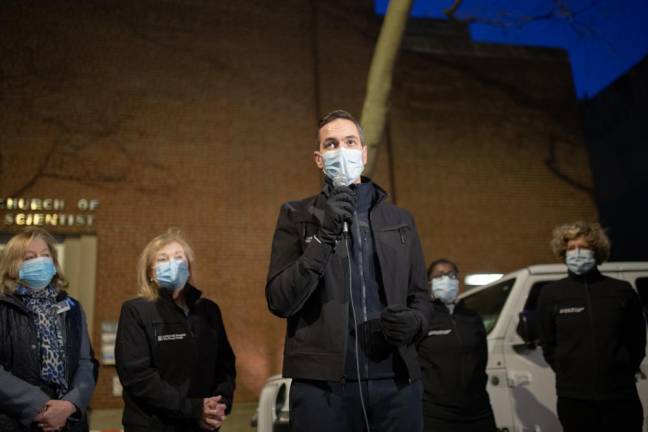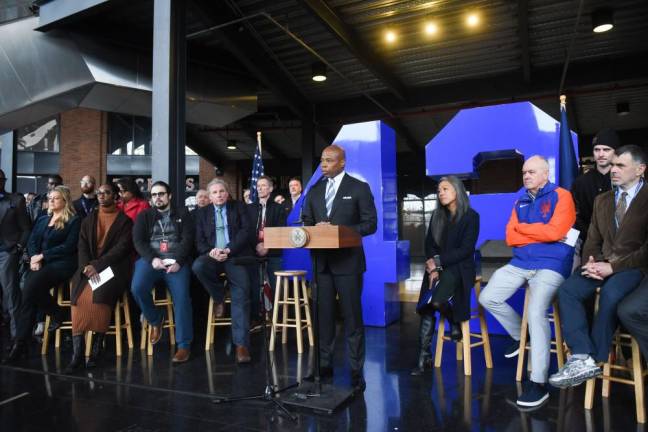COVID Spring’s Hard Choices
Lenox Hill’s medical director talks about the trade-offs between reopening society and preserving safety


Perhaps it is the legacy of all the loss he and his colleagues have endured that the number zero – the absence of anything – now brings a smile to Dr. Daniel Baker’s face.
That smile is still hidden behind a mask because, of course, after all this, we can’t fully relax our protections for patients, staff and even the widening pool of visitors to Lenox Hill Hospital. Those masks will probably remain for a long time, he said, because COVID-19 will remain out there for a long time.
But right now, inside the hospital in this COVID spring, what is absent is what is palpable.
“Now, we’re in a very good place,” Baker, the hospital’s medical director, reported Thursday. “We happen to, for the past few days, have no COVID in the hospital, which is just always fun to say. I know it’s not sustainable in the long run, but when I see that number of zero, it just brings a smile to my face.”
Baker has earned that smile. Two years ago, like every hospital in New York, Lenox Hill, a part of the Northwell Health system, was inundated by the first wave of the pandemic.
“It just was so powerful to see everybody want to help, everybody want to take part,” Baker said of how the hospital staff rose to that moment. “Everybody just came running and said, ‘What can we do?’”
Lenox Hill was praised last week as one of “24 stand-out hospitals that provided exceptional care while treating the highest volumes of coronavirus patients” in the early months of the pandemic, said Healthgrades, a medical website which evaluates doctors and hospitals using Medicare data to track how their patients do.
It is surely a memorial to what a dire time that was that the measure of success, as defined by Healthgrades, was that these 24 hospitals across the country held the mortality rate of their COVID patients under the national average of roughly one death in four (24.6 percent mortality, to be precise).
Lenox Hill was one of three New York City hospitals to make Healthgrades list. The others were NewYork-Presbyterian/Weill Cornell Medical Center and NYU Langone Health Tisch Hospital.
“In the midst of uncertainty, these hospitals acted quickly to deploy strategies to support staff and provided top-notch care for their patients and community,” Healthgrades concluded.
Earned Wisdom
It is certainly fitting to honor these health workers, with clanging pots and pans, as we did then, or with press releases and shout outs, as we do now.
But perhaps the most significant homage would be to listen to their earned wisdom as we struggle to find the right balance between reopening society and preserving safety.
Clearly, we are struggling.
Infection rates bottomed out a couple of weeks ago but are edging back up with the emergence of yet another variant, Omicron BA.2. Mayor Eric Adams acknowledged that he was pressured in both directions over his decisions to end masking for little kids in school and to start carving exceptions to the mandate that requires workers, both public and private, to be vaccinated.
“I received calls from people who were against and for,” Adams said of the vaccine rules. “That happens in this city.”
Adams found himself in the political soup by week’s end when he announced that unvaccinated professional athletes could begin playing home games, just in time for the basketball playoffs and opening day of baseball, while ticket takers, beer sellers and all other employees of private companies, as well as city agencies, would remain barred from work unless they got jabbed.
Adams stressed that the city’s sports teams were major engines of the economy, which no one doubts. But many people, and not just the unions for city workers, said the exception for well paid professional athletes seemed elitist and illogical.
“I’m worried about the increasingly ambiguous messages that are being sent to New Yorkers about public health during this continuing pandemic,” said the speaker of the City Council, Adrienne Adams.
“Different Environment”
Back at Lenox Hill, Baker watches with a recognizable empathy for how hard, as well as how crucial, these choices are.
“I think that we’ve been attempting to be a lot more fluid with our policies of how can we adapt quickly to the different environment, whether it’s low prevalence of COVID or an increasing prevalence of COVID,” Baker observed. “And how do we really continue to communicate to everybody both in the hospital as well as the community what needs to be done at the moment?”
Baker faced his own challenging trade-off just this week. Visitors have a hugely positive effect on helping patients, he noted, but of course they also increase the risk of spreading COVID. So as infection rates fell and testing has become easily available, the hospital made an important decision. Beginning Monday, visitors will be welcome again, 24/7, for the first time since March 2020.
“For many people, they really need somebody there with them,” Baker said. “It’s a very fascinating level of that trade-off.”
Which of course illustrates how the hospital cannot help but operate within the decisions made in the larger society. While society debates mask and vaccinate requirements, Baker actually focuses his advice on another less often discussed measure proven to reduce spread of the virus.
“What’s the ventilation like in the space where I am?” he asked.
“One of the most important things that is part of COVID transmissibility is the ventilation. Really adequate and improved ventilation systems have been shown to be very, very effective. More so than the six feet apart, component.”
Same Direction
We have come a long way, it seems, since “flatten the curve” first dramatized to the general public how our choices could protect or overwhelm the entire public health care system.
Yet the challenge remains of getting everyone pulling in the same direction.
“There’s certainly still multiple messages, whether you’re watching the CDC or you’re watching the FDA, or you’re watching left versus right, media. But I think there’s still at least a better acceptance for the science and the data that’s now coming out on a more regular basis.”
“I wish we were less dichotomous in opinion,” he added. “There’s a little bit of a concern amongst the health care industry of: ‘if we fully relax and relax all measures, that there’s the potential to suddenly see an increase.’ And that’s certainly possible.”
Recognizing that change is the only constant with COVID is essential, Baker explained. “And that’s some of the things I think we’re going to have to just be able to nicely discuss. Are we willing, as a society, to do that, and have small tests of change like that, but also be willing to then go back a couple steps? Can we all change together with this? As we learn about it? But there’s understandably a lot of anxiety.”
“Are we willing, as a society to ... have small tests of change ... but also be willing to then go back a couple steps?” Dr. Daniel Baker, Lenox Hill Hospital